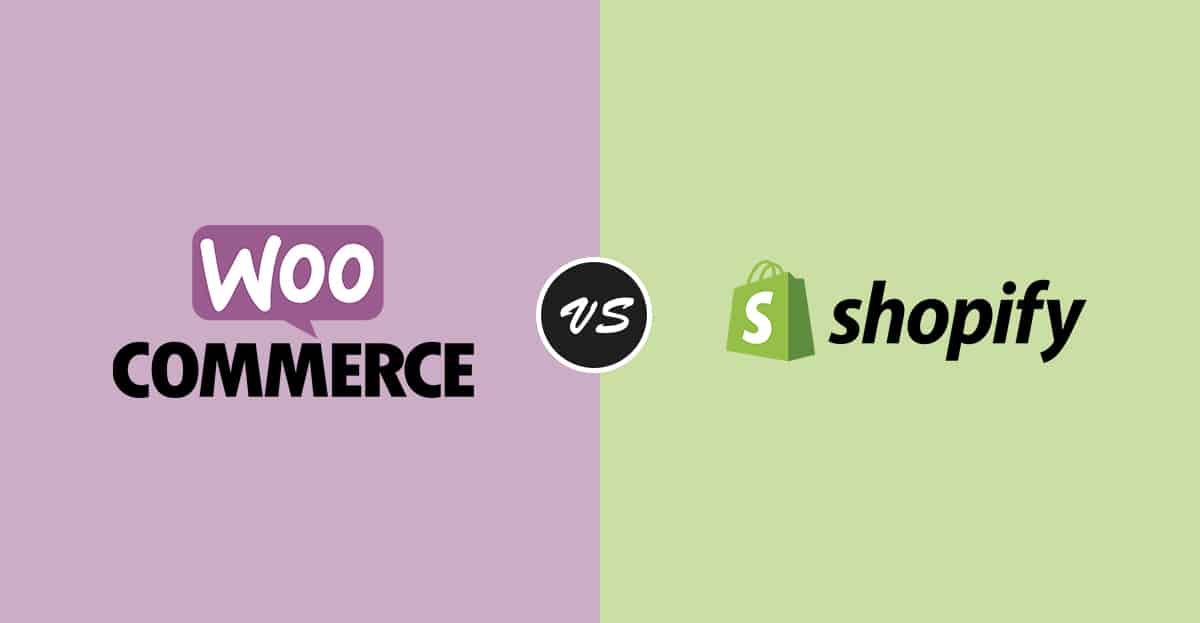Anne is an MBA and PMI certified Project Manager and former merchant and brand owner of a health and beauty brand. With an incredible depth and breadth in Shopify and its ecosystem, Anne leads our amazing Project Management Office, focusing on health and beauty, consumables, and subscription related brands.
Month: October 2020
Taylor Payne
As an actor, Taylor adores the storytelling of agency and business-to-business marketing. She holds certifications in Google Analytics and HubSpot and graduated with her Masters degree in Marketing, Graphic Design, and Computer Sciences.
Shopify vs WooCommerce; Which eCommerce Platform is Right for you?

If you know that you want to start selling online you now need to consider which platform you want to use to build your store.
Sometimes taking the first step is the hardest part of the journey. If you know that you want to start selling online you now need to consider which platform you want to use to build your store. Shopify and WooCommerce are 2 of the most popular platforms around and both have their pluses and minuses. This article will review the features of both eCommerce platforms, if you have any questions about functionality for either one, reach out and we can assist.
PRICING & FEATURES MATRIX
| Shopify | WooCommerce | |
| Monthly Fee | $29, $79, $299 and Shopify Plus | Free |
| Hosting | Free | Shared Host $10/month, VPS $40/month and up |
| SSL Certificate | Free | Free – With Let’s Encrypt |
| Credit Card Processing Fees | 2.9% – 2.4% + 30 cents | 2.9% + 30 cents |
| Multi Currency Payments | Yes – With Multiple Stores | Yes – With Custom Development |
| Multiple Languages | Yes – Apps or Multiple Stores | Yes – Variety of Options |
| PCI Compliance | Yes | Yes – With Certain Processors |
| Design | Free Themes + Custom Options | Free Themes + Custom Options |
| Blog | Yes – Limited Compared to WP | Yes |
| Uploading Products | Yes – via CSV | Yes – via CSV, XML |
| Discount Codes | Yes – but only 1 code per purchase | Yes |
| Shipping | Yes – Requires Customization | Yes – Requires Customization |
| Cart & Checkout Page | Cart Editable, Not the Checkout | Both Fully Editable |
| Developer Options | Yes – Experts Program | Yes – Experts Program |
| Quickbooks Integration | Yes – with Apps | Yes – with Plugins |
| Salesforce Integration | Yes – with Apps | Yes – with Plugins |
| Taxes | Yes | Yes |
| SEO | Yes – with limited Apps | Yes – plenty of Plugins |
Hosted Platform vs Self Hosting
Let’s start the comparison off by discussing how hosting works with both WooCommerce and Shopify. With Shopify the answer is easy, they will host your site for you and it’s included in the monthly price you pay of $29, $79 or $299.
With WooCommerce you will need to find a hosting company for your new site. We recommend getting a virtual private server (at a minimum) because if you opt for a shared host (these are typically cheaper like $10/month or less) there is a stronger chance your site could get hacked.
SSL Certificate
What is a SSL certificate? SSL certificates allows you to transmit encrypted transactions via the HTTP protocol, it adds the “s” on the end so that your URLs all become HTTPS. Shopify includes a SSL certificate with their hosted store so there is no need for you to set one up on your own.
When setting up WooCommerce you will want to purchase a SSL certificate. These typically cost about $70/year, but just recently a new company sprang up called Let’s Encrypt that allows you to install a free SSL certificate and automate it so that it gets renewed each year (this is a huge plus!).
Credit Card Processing Fees
Both Shopify and WooCommerce offer comparable fees for payment processing. With Shopify you need to use Shopify Payments to process credit card transactions unless you want to pay an extra .5% – 2.0% to use your own external payments gateway. You can use your own payment processor and pay 0% for gateway fees with Shopify if you upgrade your account to Shopify Plus, that’s a much higher level monthly plan that we will discuss further on in this comparison.
I’m going to choose Stripe for the WooCommerce payment processor. Stripe is very easy to work with, has good rates and a strong API (which comes in handy if you want to do custom development work). You could also use PayPal, but working with their API is no picnic and accepting credit card payments via Stripe is much easier than doing the same thing with PayPal.
| Shopify | WooCommerce (Stripe) | |
| Credit Card Rates Online | 2.9 – 2.4% + 30 cents | 2.9% + 30 cents |
| Credit Card Rates in Person | 2.7% – 2.4% + 0 cents (using Shopify POS) | 2.9% + 30 cents (using Stripe app) |
Overall you can see the credit card processing fees are in the same ballpark with both Shopify and WooCommerce.
Multi Currency Payments
Shopify doesn’t have an elegant solution here. The easiest way to do this is to setup multiple “clone” stores in the countries you want to sell in so that you can show the native currency price on your checkout page. It’s important to note that Shopify will only show one currency per store on your checkout page and you are unable to edit your checkout page. If you upgrade to Shopify Plus you can add clone stores to sell in multiple countries and you can also edit your checkout page.
One way to help mitigate the multi currency problem in Shopify is to set up geo IP location and pop up a notice to direct your customer to your other Shopify site. For example if you determine that a Canadian customer is on your US site you can create a popover that will let them know they should navigate to your Canadian store to see your store in the proper currency.
With WooCommerce you have almost unlimited customizations and setting up multi currency sites is possible. It will require custom programming to set everything up but there are no inherent limitations.
Multiple Languages
For Shopify merchants that want to set up their store with multiple languages there are two primary options: choose an existing app or set up multiple stores (as covered in the section above about currencies). Langify is a popular multilingual Shopify app that will do automatic language detection (based on IP address) as well allow for language switching back and forth.
WooCommerce can support sites with multiple languages and you have a few options. You could install Google Translate with a drop down option to switch languages and while this is the easiest implementation, Google Translate is notoriously inaccurate. The better route is to have your content translated by a professional and setup your site so there are drop down options for users to select different languages. You can put each of the languages on a separate sub domain if you want to keep each of the different languages clean and separate from the main site.
PCI Compliance
Shopify is PCI compliant and certified as Level 1 PCI DSS compliant. With Shopify your store is automatically PCI compliant and their certification covers your store.
With Stripe you will need to make sure you are compliant with the PCI Data Security Standards (PCI DSS). The easiest way to do that is to setup Stripe Checkout as it meets the requirements and security constraints of the Self-Assessment Questionnaire (SAQ), SAQ A, by performing all transmission of sensitive cardholder data within an IFRAME served off of a stripe.com domain that is controlled by Stripe.
Design
There are oodles of themes for your Shopify store, both free and paid. If you are just starting out with your business, choosing a free theme can help you get rolling. If you have an existing business and want to start out with Shopify you can hire an agency to create a custom design and develop a store that fits exactly what you need.
Like Shopify WordPress also has a variety of free and paid themes for you to choose from. WooCommerce will require more customization of the purchase path than Shopify and you will need a developer to help with that, we’ll cover that in more detail in a section below.
Blog
Shopify comes with a built in blogging engine that can be enabled and styled to allow you to start creating posts about your business. The rich text editor that Shopify uses isn’t as robust as what WordPress has setup and you will find many people have issues with it. The HTML markup that Shopify’s blog creates can make it difficult to work with especially if you are coming from using WordPress as your regular blog.
WordPress is well known as a robust blogging platform and is very easy to use. There are number of plugins and customizations you can make to WordPress to get setup and blogging with your WooCommerce store.
Uploading Products
Shopify allows you to bulk upload products from a CSV file. You will need to include the following information: Handle (unique name for the product), Title, Body (which is the description of the product), vendor, type, tags (these allow for additional search functionality on the site), options, price, images, skus, variants and much more.
With WooCommerce you can import products via CSV or XML file or even CSV via AJAX. There are a number of plugins that you can use to help you import your product catalog if you have created it somewhere else or you are migrating platforms. WooCommerce also has a CSV product import suite for importing products with prices, descriptions, images, meta fields and you can even create custom fields depending on what attributes about your products you want to store.
Discount Codes and Coupons
On Shopify you can create discount codes for a dollar amount, a percentage off or for free shipping. You can create multiple discount codes and maintain them via your Shopify dashboard. However a customer can not use more than one discount code at a time on Shopify and this can be a painful situation. Say you want to offer free shipping and 30% off as 2 different coupon codes a customer can’t use both of those during checkout at the same time.
WooCommerce has a dashboard for managing and adding coupon codes. You can create cart discounts, for example if the customer purchases more than 2 of 1 item they get a discount of 15% on the entire purchase. You can set up product discounts for fixed amounts ($20 off) and you can create percentage discounts. In addition you can create free shipping coupons (very popular) and you can limit how many times a coupon is used in total or per customer.
Shipping
You will need to decide which carriers you want to use to ship your product, UPS, Fedex, common carriers, etc. Once you decide that you need to think about how you are going to manage your shipments (printing packing slips, tracking inventory, etc). Many of our clients are very happy with ShipStation and use them to manage shipments across all their channels: Amazon, eBay, Walmart, Jet, their website, etc.
With Shopify you can easily integrate ShipStation (make sure that you don’t set your inventory status set to “fulfilled” in Shopify or ShipStation won’t sync) or you can manually track your shipments offline. Next you need to set your shipping rates and this is where Shopify starts to have some issues. You can set your shipping rates by state, but if you want to get more granular and set your rates by zip code you will need to install an app and upgrade your Shopify account to the $79/month for the carrier calculated shipping feature.
With WooCommerce you can fully customize your shipping settings via 3rd party plugins or you can customize your shipping rates, fees, charges etc by custom coding everything. You can get shipping rates from UPS, USPS, print shipping labels and much more with WooCommerce.
Cart & Checkout Page
Both Shopify and WooCommerce will let you customize the shopping cart page, customize buttons, colors, layout, etc. With WooCommerce you can customize the checkout page fully, but on Shopify you are restricted from updating the checkout page. This can be a problem for Shopify stores that want to display different currencies (as described in the currency section). The best option here is to set up “clone” stores in Shopify or even better is to upgrade to Shopify Plus and you can fully configure the checkout page how you need it.
Developer Options
If you need a developer for Shopify, the best place to look is the Shopify Experts page. If you are a large eCommerce store you will want to consider reaching out to a Shopify Plus Expert.
WooCommerce also has an expert program, you can search by agency, their service and product specializations and the project scope.
Quickbooks Integration
Shopify merchants can install the Intuit Quickbooks app to sync up Shopify with Quickbooks online. Once you connect the 2, you can save hours of work each work entering in sales, tax and customer data that will automatically be ported over to Quickbooks. You will need to choose a date range for the orders you want to export from Shopify to Quickbooks and then you can set how often you want to sync your orders, daily, weekly or monthly.
WooCommerce also has a Quickbooks extension to sync your accounting data on a regular basis. You can also matchup up customers by name and company in Shopify and Quickbooks so you can make sure you are sending over the right information.
Salesforce Integration
If you are looking to keep track of your Shopify customers in Salesforce, you can consider using the Zapier app. You can add customers as contacts in Salesforce and track the products they’ve purchased in Shopify. Bit of caution with Zapier in that depending on how you are using Salesforce (and Shopify), the mapping may not work out smoothly. We had a customer where we had to create a custom cron job to sync up the data between Salesforce and Shopify to make sure everything was working correctly.
Zapier also has a an app for WooCommerce that functions very similarly to the Shopify one. You can create triggers and actions for different events: when a new account is created, new task built, new contact etc.
Taxes
Shopify will track and show tax information based on your retail location. Shopify doesn’t automatically set up tax rates for countries outside of your home country, it’s up to you to set that rate up. If you are a Shopify Plus customer you can get access to Avalara tax rates, which are much more accurate and comprehensive than the standard Shopify tax rates.
WooCommerce has settings where you can enable tax calculation and the display of taxes on your checkout page. There are a lot of options in WooCommerce for taxes, you can change how you calculate the taxes, how you display the rates, totals, etc. You can even upload your own tax rates with Woo, there is a lot of flexibility in how you set everything up.
SEO
There are a lot of things that go into SEO: site architecture, content, images, video, social signals, backlinks and much more. The majority of your rankings will come from areas that you can control, adding unique content, getting links and creating a site that is worthy of being ranked by Google. As far as site architecture Shopify does all the things that you need to create and rank a site. WordPress has a head start with overall SEO and especially with their thriving plugin ecosystem. The Yoast SEO for WordPress plugin has tons of features, keyword and content analysis, meta tag configurations, breadcrumbs, sitemaps and much more. Shopify has some SEO apps, but none as comprehensive and established as Yoast – in time it wouldn’t surprise me if Yoast developed an app for Shopify.
Todd Williams
Todd has a rich background in software development and architecture. He excels in translating complex technical concepts into strategic business solutions, bridging the gap between development teams and executive goals. Known for clear, effective communication, Todd adeptly links technical intricacies with business strategy, driving companies to thrive in the digital marketplace.
Matt Peters
Matt is the Chief Technology Officer for Ambaum, setting development tempo and solutioning for both front-end and back-end development. Having worked on and around Shopify for 10 years, Matt has a passion for teaching and helping team members and brands.
David Stober
14 year eCommerce merchant, business builder, digital, and growth marketing leader, and Shopify Plus merchant since 2013. David leads operations, creative, and strategy at Ambaum and works with clients ranging from startup DTC brands to high growth, venture-backed companies.
Chad Fisher
Chad began his career with PricewaterhouseCoopers supporting large Fortune 500 brands in the US and internationally. After leaving corporate America, Chad founded Ambaum to help early stage e-commerce brands and was one of the first agencies accepted into the Shopify Plus program in 2016.
Seven Coffee Roasters

Ambaum has been supporting Seven Coffee Roasters since late summer in 2019. Sean Lee approached Ambaum looking for help with a number of services: Shopify site updates, strategy and consulting, design and online advertising help. David Stober, Ambaum’s COO met with Sean and mapped out an initial strategy to help him grow the revenue through his online Shopify store.
The first thing David and Sean discussed was getting a new look and feel for the Seven site. Sean started Seven Coffee Roasters in a small cafe/roastery in the Greenwood neighborhood of Seattle with the mission of bringing Hawaiian coffee to the mainland. Ambaum setup Seven with a new theme that brought together two brands under one main site and gave everything a smoother and more streamlined look.
A big focus for Sean was getting more customers signed up with a monthly subscription for his coffee. Seven was already leveraging Recharge’s Shopify app for managing subscriptions but they weren’t getting the most out of it. David and Sean spent many months designing and building out a new product detail page and the outcome was this:

This enhanced product detail page saw a large increase in customers that signed up for a subscription. Before Sean started working with Ambaum he had less than $500/month in subscription customers and within 6 months he was approaching $8,000/month in total subscription revenue.
Fantastapack

Fantastapack believes every business deserves beautifully printed packaging. Fantastapack approached Ambaum in 2018 looking for help with configuring their product detail page to price out large and bulky items. Due to the custom nature of their products, they calculate each custom order’s price based on the size, quantity, and material of the boxes. Formulas for calculating the box dimensions and pricing are stored in Shopify metafields and pricing information is passed on through line item properties and used by a checkout script to set the correct price in checkout.
A lot of our day-to-day work with them has been focused on making front-end improvements and fixes to the site. The complex nature of their PDP means that adding new customization options often requires developer assistance in editing the template to add these new features. One major task Ambaum we accomplished was building a template for a new product, precut box bundles. These products come in a range of predetermined sizes with pre-printed patterns, so customers can order a simple set of boxes when they don’t need a fully custom option. This new product required some custom pricing logic of its own, as the client wanted to offer an increased discount for larger bulk orders. Ambaum came up with code using JavaScript and checkout scripts to calculate the price based on the selected size and quantity of the boxes to arrive at the appropriate discount.

The VP of Innovation had an idea in 2019 to make it easier for their resellers to place high volume orders. Using Fantastapack.com to enter orders worked for smaller customers, but resellers placing large and frequent orders found it tedious to place orders through the standard checkout process. Ambaum worked with Fantastapack to architect a solution that involved creating a React front end application in conjuction with a Laravel framework to handle the order processing and artwork uploads from resellers. Ambaum also setup API connections to internal Fantastapack systems and integrated Ship Engine APIs to allow resellers to enter their own UPS, Fed Ex and USPS shipping rates. The custom software Ambaum created is now an integral part of Fantastapack’s operations and a valuable tool for resellers to place frequent orders.
Deep Sentinel

Deep Sentinel
Shopify | Ecommerce| New Site Build
The Client
Deep Sentinel is the next-gen home security solution that stops crime before it happens. Powered by a proprietary AI, HD smart cameras, and 24/7 LiveSentintel™ personal security guards, Deep Sentinel sets the new standard in home protection. Deep Sentinel protects your home and proactively stops burglary, package theft, or driveway break-in, allowing customers to feel dramatically safer at home.
The Overview
Deep Sentinel was a new company looking to sell their proprietary home security product through an ecommerce site. This required a full site build and a custom theme created in Shopify. We had to set up purchasing to handle the initial cost for the physical product as well as a recurring subscription cost for the service that could be annual or monthly. Their store is currently active, generating sales and can be viewed here: Deep Sentinel
The Challenge
Deep Sentinel came to us as a new store looking to sell their next-gen proprietary home security solution through an ecommerce site. Being a new company selling a new-to-the-market product, they had no site and no customer base. This meant our job was to build an entire site from the ground up that would draw customers in and showcase the product to make great first impressions.

The Process
This build required us to create a custom theme in Shopify. The actual product catalog of the site is relatively simple, so the focus of the build was on design to really feature and sell the product. There was some complex configuration we had to do to set up the subscriptions for the products. Deep Sentinel has an initial cost of the physical product and then the subscription kicks in for the service. We also had to set up a monthly subscription and an annual subscription and provide customers with the ability to toggle between the two before the final purchase.
The Solution
Deep Sentinel is a subscription-based online store that is built on the Shopify platform. The site needed to be the start of building a relationship of trust with customers. That meant building a high grade site that is easy to navigate and guides customers to all the information they need. The purpose of the site is to provide customers with a more comprehensive security system that has 24/7 “Live” surveillance. The store is currently active and generating sales.
The site can be viewed here: Deep Sentinel
The Result
“Hands-down…an invaluable asset for our company. [They are] extremely knowledgeable, work is top grade, and the turn-around is amazing. I would highly recommend Ambaum for UX and back-end work in Shopify.”
